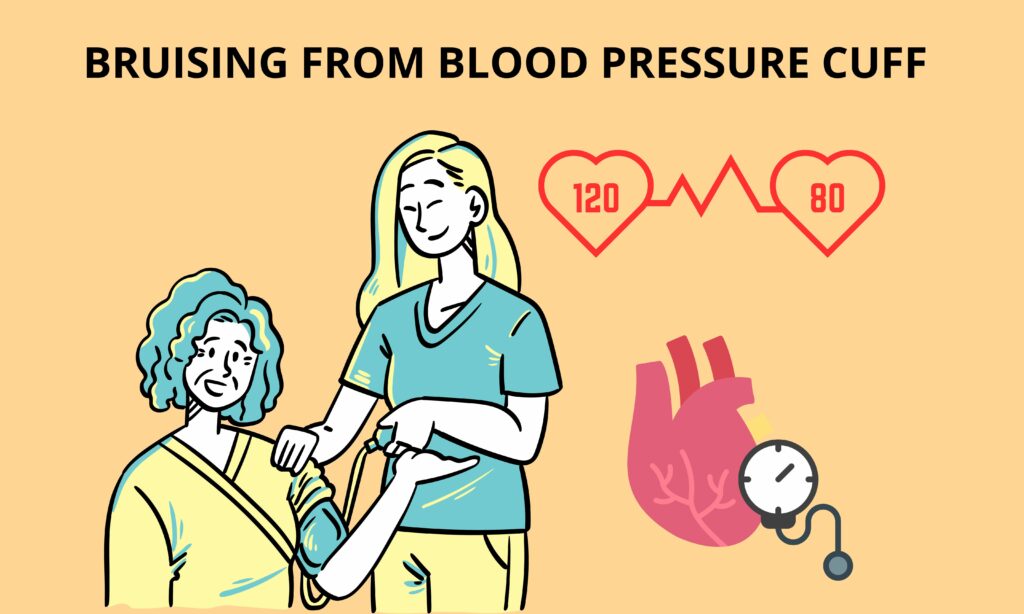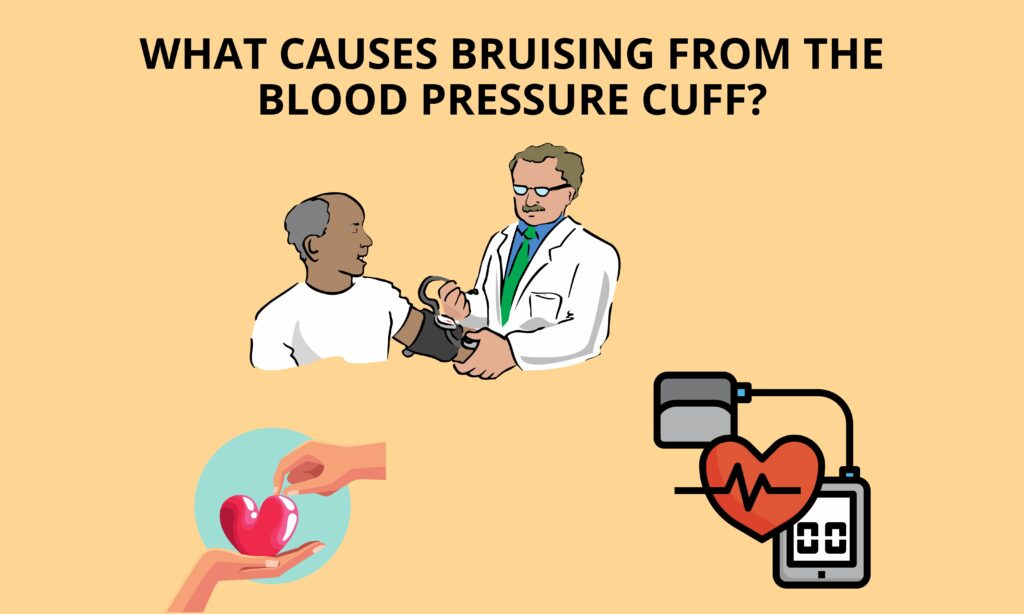
Blood pressure cuff bruising is a common occurrence, especially in individuals with delicate or sensitive skin. It occurs when the blood pressure cuff is applied too tightly, causing the blood vessels in the area to rupture, leading to discoloration of the skin.
Size of the cuff – Several factors can contribute to blood pressure cuff bruising. One of the primary factors is the size of the cuff. If the cuff is too small, it can cause undue pressure on the arm, leading to bruising. On the other hand, if the cuff is too large, it can cause the pressure to spread over a larger area, leading to discomfort and bruising.
Duration of the pressure – Another factor that can contribute to blood pressure cuff bruising is the duration of the pressure applied. If the cuff is left on for too long, it can cause the blood vessels to rupture, leading to bruising. It is essential to ensure that the blood pressure cuff is removed after the appropriate amount of time has elapsed to avoid potential complications.
In some cases, the skin’s sensitivity and fragility can also lead to blood pressure cuff bruising. Individuals with thin or delicate skin may be more prone to bruising and discomfort from the pressure applied by the cuff.
It is essential to monitor the skin’s appearance after a blood pressure test to watch out for potential complications. In some cases, the bruising may be minor and resolve on its own within a few days. However, if the bruising is severe or accompanied by other symptoms such as pain or swelling, it is important to seek medical attention.
Additionally, individuals with a history of bleeding disorders or who are taking blood-thinning medications should be particularly cautious when using a blood pressure cuff. They should inform their healthcare provider to ensure that the cuff is applied safely and appropriately to avoid potential complications.
In conclusion, blood pressure cuff bruising is a common occurrence that can happen to anyone, especially those with delicate or sensitive skin. It is important to use the correct size cuff and monitor the duration of the pressure applied to avoid potential complications. Individuals should watch out for any bruising or discomfort and seek medical attention if necessary, particularly if they have a history of bleeding disorders or are taking blood-thinning medications. By taking these precautions, individuals can ensure that their blood pressure tests are safe and effective.
What causes bruising from the blood pressure cuff?

Bruising from the blood pressure cuff is a common issue that can occur during a routine blood pressure measurement. A blood pressure cuff, also known as a sphygmomanometer, is an essential medical device used to measure blood pressure. The cuff is wrapped around the arm, and air is pumped into it to apply pressure to the brachial artery. The pressure is then slowly released, and the healthcare provider records the blood pressure measurement. However, this procedure can sometimes lead to bruising of the arm, which can cause pain and discomfort.
- One of the most common causes of blood pressure cuff bruising is the use of a cuff that is too small or too large. A cuff that is too small can apply excessive pressure to the arm, which can cause the blood vessels to rupture, leading to bruising. On the other hand, a cuff that is too large can cause the pressure to spread over a larger area, leading to discomfort and bruising. To avoid these complications, healthcare providers use a cuff that fits appropriately for the patient’s arm circumference.
- Another cause of blood pressure cuff bruising is the amount of pressure applied to the arm during the measurement. If the healthcare provider pumps the cuff to a pressure level that is too high, it can cause the blood vessels in the arm to rupture, leading to bruising. In contrast, if the pressure level is too low, the blood pressure reading may be inaccurate, and the healthcare provider may need to repeat the measurement, which can lead to bruising.
- The duration of the pressure applied by the cuff is also a contributing factor to bruising. If the cuff is left on for too long, it can cause the blood vessels to rupture, leading to bruising. It is essential to ensure that the blood pressure cuff is removed after the appropriate amount of time has elapsed to avoid potential complications. The healthcare provider should follow the manufacturer’s instructions regarding the amount of time the cuff should remain on the arm.
Individuals with thin or delicate skin may also be more prone to bruising and discomfort from the pressure applied by the cuff. In some cases, the skin’s sensitivity and fragility can also lead to blood pressure cuff bruising. If the patient has any skin conditions or allergies, they should inform the healthcare provider before the blood pressure measurement is taken.
It is important to note that blood pressure cuff bruising can be more severe in individuals with a history of bleeding disorders or who are taking blood-thinning medications. These individuals are more prone to bleeding and bruising, and the use of a blood pressure cuff can increase their risk of complications. They should inform their healthcare provider to ensure that the cuff is applied safely and appropriately to avoid potential complications.
In conclusion, blood pressure cuff bruising can occur due to several factors, including the use of the wrong cuff size, applying too much pressure, leaving the cuff on for too long, and skin sensitivity. Healthcare providers should ensure that they use the appropriate cuff size for each patient and follow the manufacturer’s instructions regarding the pressure level and duration of the cuff’s application. Individuals should inform their healthcare provider of any skin conditions or allergies before the blood pressure measurement is taken. Patients who have a history of bleeding disorders or are taking blood-thinning medications should inform their healthcare provider to ensure that the cuff is applied safely and appropriately. By taking these precautions, healthcare providers can ensure that their patients’ blood pressure tests are safe and effective, without causing undue pain or discomfort.
FAQs

Here are some frequently asked questions about blood pressure cuff bruising:
Q: Is bruising from a blood pressure cuff normal?
A: It is not uncommon to experience some bruising or discoloration around the area where the cuff was applied. However, excessive bruising or pain is not normal and should be reported to your healthcare provider.
Q: How long does it take for blood pressure cuff bruising to go away?
A: Typically, blood pressure cuff bruising will go away on its own within a few days to a week. However, if the bruising is severe or lasts longer than a week, it is important to speak with your healthcare provider.
Q: How can I prevent blood pressure cuff bruising?
A: To prevent blood pressure cuff bruising, make sure that the healthcare provider uses the appropriate cuff size for your arm circumference. Additionally, inform your healthcare provider of any skin conditions or allergies you may have. It is also important to avoid excessive pressure by ensuring that the cuff is not inflated too high, and it is removed after the appropriate amount of time has elapsed.
Q: What should I do if I experience excessive bruising or pain after a blood pressure measurement?
A: If you experience excessive bruising or pain, it is important to contact your healthcare provider immediately. They may recommend over-the-counter pain relievers or other treatments to help alleviate your symptoms.
Q: Can blood pressure cuff bruising cause long-term damage?
A: In most cases, blood pressure cuff bruising will not cause any long-term damage. However, if the bruising is severe or if it occurs frequently, it is important to speak with your healthcare provider to rule out any underlying medical conditions.
Q: Are there any alternative methods for measuring blood pressure that do not involve a cuff?
A: Yes, there are alternative methods for measuring blood pressure that do not involve a cuff, such as using a wrist or finger monitor. However, these methods may not be as accurate as using a cuff, and they may not be suitable for everyone. It is important to speak with your healthcare provider to determine the best method for measuring your blood pressure.
Conclusion
In conclusion, bruising from a blood pressure cuff is a common occurrence that can happen to anyone, but excessive bruising or pain should not be ignored. While most bruises will go away on their own within a few days to a week, severe or long-lasting bruising should be reported to your healthcare provider.
To prevent blood pressure cuff bruising, it is important to use the appropriate cuff size for your arm circumference and to inform your healthcare provider of any skin conditions or allergies. Additionally, it is important to avoid excessive pressure by ensuring that the cuff is not inflated too high and is removed after the appropriate amount of time has elapsed.
If you experience excessive bruising or pain after a blood pressure measurement, it is important to contact your healthcare provider immediately. They may recommend over-the-counter pain relievers or other treatments to help alleviate your symptoms.
It is important to note that while blood pressure cuff bruising is usually harmless, it may be an indication of an underlying medical condition. Therefore, if you experience frequent or severe bruising, it is important to speak with your healthcare provider to rule out any underlying medical conditions.
Finally, while there are alternative methods for measuring blood pressure that do not involve a cuff, such as using a wrist or finger monitor, it is important to discuss these options with your healthcare provider to determine the best method for measuring your blood pressure.
In summary, while bruising from a blood pressure cuff is common, it should not be taken lightly. Proper precautions and communication with your healthcare provider can help prevent excessive bruising and ensure accurate blood pressure measurements.